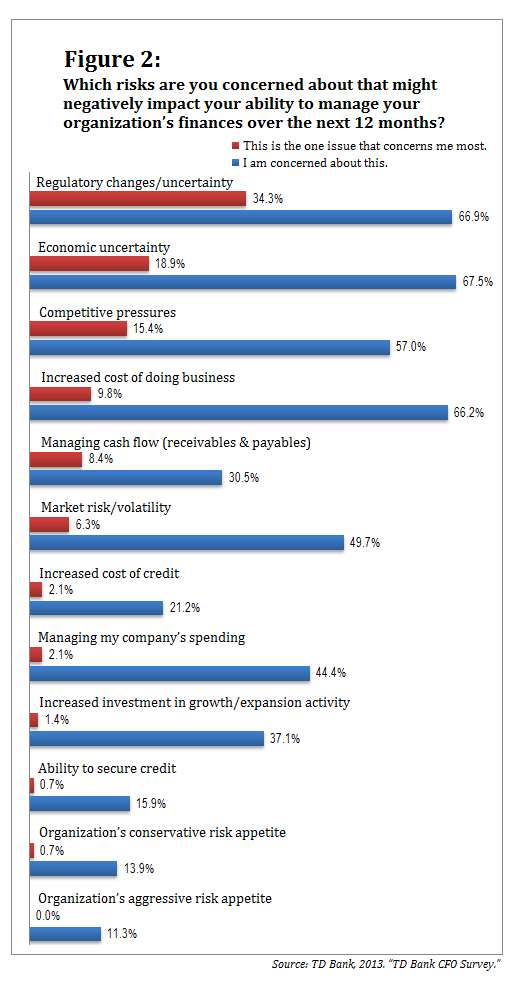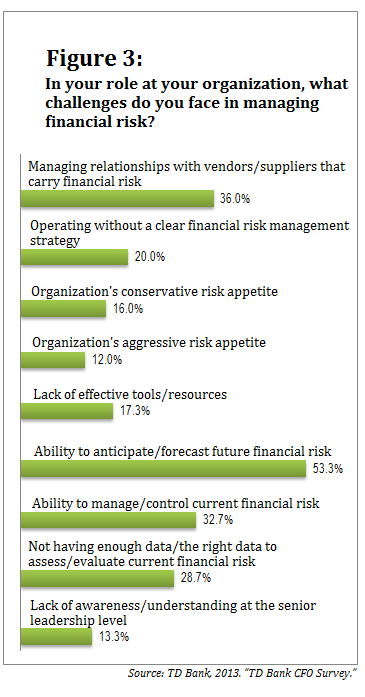To understand finance professionals' feelings about financialrisk management, as well as their thoughts on the economy overall,TD Bank polled CFOs, controllers, treasurers, and directors offinance from across the United States. Respondents come from bothmidmarket companies, defined by TD Bank as being under $250 millionin annual revenue, and “corporates,” defined as organizations withrevenues above $250 million.
|The survey revealed that these executives' confidence in theU.S. economy is increasing—and their confidence in their ownorganization is growing even faster. The largest proportion (41percent) said they are more confident about the U.S. economicoutlook over the next 12 months than they were over the previous 12months. Thirty-one percent said they're less confident today, and29 percent said their confidence level hasn't changed in the pastyear.
|But when asked how they feel about the prospects for theirorganization over the next 12 months, vs. the previous year, a full60 percent said they're more confident, and nearly half of those(26 percent of all respondents) said they're much more confidenttoday. In contrast, only 11 percent of respondents are lessconfident about the next year than the past year, and only 3percent are much less confident. Fred Graziano, head of regionalcommercial banking and executive vice president with TD Bank, saysthese numbers are up from the bank's 2012 survey: “The differencefrom a year ago is that companies are feeling a little bit betterabout themselves and how they manage their business.”
|Indeed, many of the organizations represented in the survey havemade substantial changes to their risk management policies in thepast several years. Half have gained more visibility into theircash position since the start of the financial crisis, and nearlyas many have begun evaluating suppliers' risk management practicesand terminating business relationships that carry too much risk(see Figure 1, below). More than a third have improved their riskreporting practices, and more than one in five have implemented anenterprise risk management (ERM) program since 2008.
|However, most organizations did not respond to the financialrisks brought to light in the financial crisis by makingsignificant management or technology changes. Only 11 percent havedeployed new risk management software, and fewer than 5 percenthave established a chief risk officer (CRO) position.
|“Companies have made internal changes, such as adding people andimproving reporting,” Graziano says, “and then externally they'vegone out and done a better job of evaluating their vendors andsuppliers. By adding more resources to risk management, they'vepositioned themselves better, both internally and externally.”
|
Although they've gained important insights into their financialrisks, most companies' willingness to take on financial riskshasn't changed much in the past year. When asked how they wouldrate their organization's current financial risk appetite comparedwith a year earlier, the majority (56 percent) said it hasn'tchanged. Nearly a quarter (24 percent) are somewhat more willing totake financial risks this year than they were last year, and 3percent are much more willing to take risks. However, 10 percentare somewhat less willing—and another 7 percent much lesswilling—to take financial risks today.
|Respondents made clear the reasons why they're reluctant to takeon new risks: They feel a good deal of uncertainty in the externalenvironment, both in terms of regulations that may be coming in thefuture and in terms of the economy and their competitiveness intheir marketplace (see Figure 2, below). “In 2008 and 2009, the bigconcern among CFOs was their ability to secure credit,” Grazianosays. “This year, that concern is near the bottom of the list.Instead, CFOs today are thinking about things like understandingfinancial risk, regulatory risk, and cash positions.”
|Indeed, when asked to identify the risk that concerns them most,more than a third of survey respondents chose “regulatorychanges/uncertainty.” Nearly 20 percent cited economic uncertainty,and 15 percent cited competitive pressures. Fewer than 1 percentsaid that securing credit is their primary concern, with 2 percentsaying they're most worried about the rising cost of credit.
|
Perhaps because external uncertainties are their number-oneconcern, more than half of the surveyed finance executives saidthat their ability to forecast future financial risk is an ongoingchallenge. Many also struggle to control their current financialrisks, in large part because they feel they don't have the rightdata to manage those risks.
|Corporate policies are creating some challenges, as well. Twentypercent of respondents said they're operating without a clearfinancial risk management strategy. And similar proportions of CFOsgrapple with their company's conservative risk appetite (16percent) as with their organization's aggressive risk appetite (12percent).
|“When you start taking on credit, and you want to invest in yourcompany—whether it's people, buildings, equipment, or other fixedassets—you want to have the ability to forecast, and you want tofeel comfortable that there's some stability, before you make thatlong-term investment,” Graziano says. “I think what this surveyemphasizes is that companies are forecasting a little better, butthere's still a lot of uncertainty about the future. CFOs wouldlike to face less uncertainty, but they're finding ways to managethose external risks.”
|
Complete your profile to continue reading and get FREE access to Treasury & Risk, part of your ALM digital membership.
Your access to unlimited Treasury & Risk content isn’t changing.
Once you are an ALM digital member, you’ll receive:
- Critical Treasury & Risk information including in-depth analysis of treasury and finance best practices, case studies with corporate innovators, informative newsletters, educational webcasts and videos, and resources from industry leaders.
- Exclusive discounts on ALM and Treasury & Risk events.
- Access to other award-winning ALM websites including PropertyCasualty360.com and Law.com.
*May exclude premium content
Already have an account? Sign In
© 2024 ALM Global, LLC, All Rights Reserved. Request academic re-use from www.copyright.com. All other uses, submit a request to [email protected]. For more information visit Asset & Logo Licensing.







